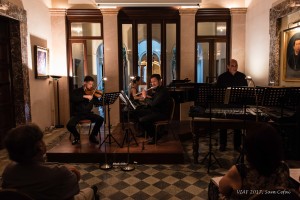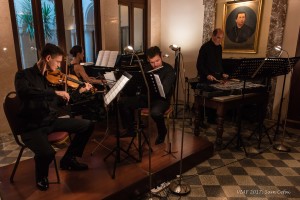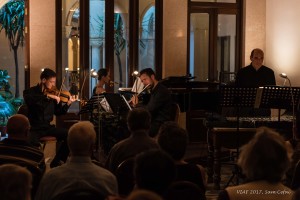Eclectic programme and refined performance by Oden Ensemble from Paris
On Sunday 25 June, the Oden Ensemble for Contemporary Music from Paris gave a most refined performance of works by Rota, Hovhaness, Joseph Vella, and Lou Harrison. Theirs is a most sophisticated style, dealing with the massive technical details of contemporary music with an ease that is both impressive and humbling.
Starting with Harrison’s Songs of the Forest for the whole ensemble, with Christoph Vella coping with numerous percussion instruments with consummate ease, this set the right tone and mood for the whole programme. Despite the title, the work is instrumental not vocal, The orchestration is flute, piano (which is sometimes fuzzed by inserting paper through the strings), percussion, and narrator. The music is brightly modal, with a calm, spiritual Eastern flavour. Balance was beautifully maintained and sustained, and the blending of the instruments was characterised by poise.
Next came Joseph Vella’s Segments no. 1 for Flute, Violin, and Pianoforte op. 93. This workis the first of a group of three compositions bearing the same title. Segments no. 2 is for String Quartet, while Segments no. 3 is for Clarinet and Pianoforte.
All three works are basically serially constructed. However, the note-row technique used is quite a personal one. Unlike the traditional forms of original, Inverted, Original Retrograde, and Inverted Retrograde, the composer takes note no. 7 of the Original and moves sideways (backwards and forwards), to create a new row, note no. 7 of which then becomes the starting point of the next row. This gives the composer a set of 10 rows, together with another 10 starting with note no. 6.
Segments no. 1 is made up of six discrete pieces. The first one, Un poco lento, led without a break into the second, Alla marcia where the main thematic material was mostly shared by the flute and the violin, with the pianoforte supporting with a steady rhythmic pattern. A short codetta on the violin took the music to the Tempo di Sarabanda. Throughout the fourth Segment, Deciso, there was a constant appearance of a 1/4 sfz (sforzando) which was used as a unifying factor in an otherwise strongly rhythmic section. This calmed down slightly towards the end with the solo flute introducing the Adagio. Most of this slow Segment developed into a dialogue between the flute and violin, the pianoforte coming in later on with a melody of its own. The closing Segment, Moderato, mostly alternated two bars of 5/8 with another two of 6/8. This irregular drive was kept right up to the end, when all three instruments played in unison. A lovely work, indeed.
The third work performed was Hovhaness’s Suite for Flute, Violin, and Pianoforte. This is the first time that this composer, born of Scottish and Armenian descent, was performed in VIAF. This very beautiful, at times haunting, Suite is highly influenced by the composer’s love of Eastern culture and traditions. In fact, the aural result of the work attested to the composer’s immersion in Eastern exoticism is a musical language invested with a sense of mysticism and spirituality.
The final work was Nino Rota’s Trio for Flute, Violin, and Pianoforte. Rota will probably always be known as the composer of music to The Godfather (1971) and to the earlier Italian film masterpiece, La dolce vita (1963). That will be a shame because Rota was highly inventive and actually had mastered all the ‘schools’ of twentieth-century music, from neo-classicism to postmodernism, particularly the trends that influenced Italian composers, with the exception of Ottorino Respighi. There is much evidence of the easy-going romantic in these chamber works, with hints here and there of Rota’s grasp of non-traditional modes of expression bordering on atonality. One such work is the wonderful Trio for Flute, Violin, and Piano (1958), a playful piece that pushed the flute into realms previously trod only by Toru Takemitsu. In fact, while generally all the Trios in middle decades of the twentieth century have traditional trio and sonata structures that pre-date Mozart, Rota always conjured a twentieth-century unease as well as moments of extreme beauty where a solo instrument will simply sing on its own. This work was impeccably delivered, with easy exchanges between the instruments and a well-articulated phraseology unifying the fragmented nature of the work.
The end of the performance was greeted with a resounding round of applause by the public.







